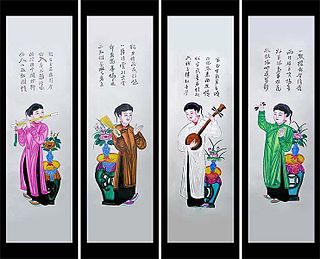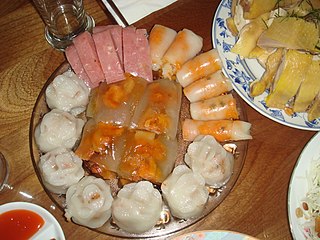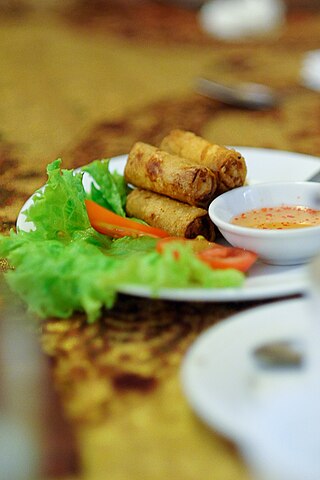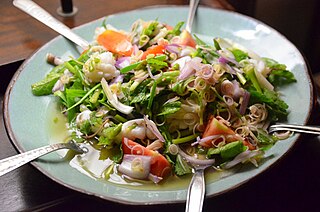
Vietnamese cuisine encompasses the foods and beverages originated from Vietnam. Meals feature a combination of five fundamental tastes : sweet, salty, bitter, sour, and spicy. The distinctive nature of each dish reflects one or more elements, which are also based around a five-pronged philosophy. Vietnamese recipes use ingredients like lemongrass, ginger, mint, Vietnamese mint, long coriander, Saigon cinnamon, bird's eye chili, lime, and Thai basil leaves. Traditional Vietnamese cooking has often been characterised as using fresh ingredients, not using much dairy or oil, having interesting textures, and making use of herbs and vegetables. The cuisine is also low in sugar and is almost always naturally gluten-free, as many of the dishes are rice-based instead of wheat-based, made with rice noodles, rice papers and rice flour.

Bulgogi is a gui made of thin, marinated slices of meat, most commonly beef, grilled on a barbecue or on a stove-top griddle. It is also often stir-fried in a pan in home cooking. Sirloin and rib eye are frequently used cuts of beef for the dish. Bulgogi is a very popular dish in South Korea, where it can be found anywhere from upscale restaurants to local supermarkets as pan-ready kits.

Korean royal court cuisine was the style of cookery within Korean cuisine traditionally consumed at the court of the Joseon Dynasty, which ruled Korea from 1392 to 1897. There has been a revival of this cookery style in the 21st century. It is said that twelve dishes should be served along with rice and soup, with most dishes served in bangjja (bronzeware).

Bò nướng lá lốt or thịt bò lá lốt, bò lá lốt is a dish consisting of Vietnamese beef in lolot leaves, which are called "betel" leaves by some English magazines. The leaves smell spicy but have a medicinal taste. The food is often served or sold at barbecues, and is the 5th out of 7 courses in the multi-course meal Bò 7 món. There is a northern version called chả lá lốt using pork instead of beef and often pan-fried instead of grilled.

Rice vermicelli is a thin form of noodle. It is sometimes referred to as "rice noodles" or "rice sticks", but should not be confused with cellophane noodles, a different Asian type of vermicelli made from mung bean starch or rice starch rather than rice grains themselves.

Gỏi cuốn, nem cuốn, salad roll, summer roll, fresh spring roll, or rice paper roll is a Vietnamese dish traditionally consisting of pork, prawn, vegetables, bún, and other ingredients wrapped in bánh tráng. Unlike other spring roll dishes, which are believed to originate from China, Vietnamese gỏi cuốn is a national creation using bánh tráng.

Bánh tráng or bánh đa nem, a Vietnamese term, sometimes called rice paper wrappers, rice crepes, rice wafers or nem wrappers, are edible Vietnamese wrappers used in Vietnamese cuisine, primarily in finger foods and appetizers such as Vietnamese nem dishes. The term rice paper wrappers can sometimes be a misnomer, as some banh trang wrappers are made from rice flour supplemented with tapioca flour or sometimes replaced completely with tapioca starch. The roasted version is bánh tráng nướng.

Bún bò Huế or bún bò is a Vietnamese rice noodle (bún) dish with sliced beef (bò), chả lụa, and sometimes pork knuckles. The dish originates from Huế, a city in central Vietnam associated with the cooking style of the former royal court. The dish has a mix of spicy, salty, and savory flavors. The predominant flavors is that of lemongrass and shrimp paste. Compared to phở or bún riêu, the noodles are thicker and cylindrical.

Chả lụa or giò lụa is the most common type of sausage in Vietnamese cuisine, made of pork and traditionally wrapped in banana leaves.

In Vietnamese, the term bánh translates loosely as "cake" or "bread", but refers to a wide variety of prepared foods that can easily be eaten by hands or chopsticks. With the addition of qualifying adjectives, bánh refers to a wide variety of sweet or savory, distinct cakes, buns, pastries, sandwiches, and other food items, which may be cooked by steaming, baking, frying, deep-frying, or boiling. Foods made from wheat flour or rice flour are generally called bánh, but the term may also refer to certain varieties of noodle and fish cake dishes, such as bánh canh and bánh hỏi.

Javanese cuisine is the cuisine of Javanese people, a major ethnic group in Indonesia, more precisely the province of Central Java, Yogyakarta and East Java.

Piper sarmentosum is a plant in the family Piperaceae used in many Southeast Asian cuisines. The leaves are often confused with betel, but they lack the intense taste of the betel leaves and are significantly smaller.

Chả giò, or nem rán, also known as fried egg roll, is a popular dish in Vietnamese cuisine and usually served as an appetizer in Europe, North America and Australia, where there are large communities of the Vietnamese diaspora. It is ground meat, usually pork, wrapped in rice paper and deep-fried.

Nem nướng is Vietnamese grilled pork sausage or grilled meatballs, and a popular Vietnamese food item, sometimes served as an individual appetizer or snack, or served with rice noodles or rice as a main course. Nem nướng is a specialty of Khánh Hòa Province . Nem nướng is a rustic dish, originating from Ninh Hoa, a northern district of Khanh Hoa province, about 30 km from the coastal city.

Salads that are internationally known as Thai salads with a few exceptions fall into four main preparation methods. In Thai cuisine these are called yam, tam, lap and phla. A few other dishes can also be regarded as being a salad.

Hot pot or hotpot, also known as steamboat, is a dish of soup/stock kept simmering in a pot by a heat source on the table, accompanied by an array of raw meats, vegetables and soy-based foods which diners quickly cook by dip-boiling in the broth.
















